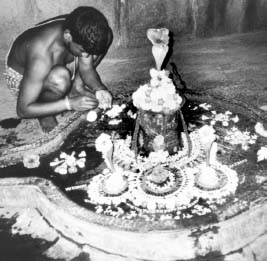HinduismReligious Beliefs |
What does Hindu tradition teach about religion and violence? |
In most religious traditions, theology and associated images of deity are always about conceptions of ultimate power. In many traditions, power in turn invariably has something to do with how a deity deals with evil, and an important ingredient in Hinduism’s various theologies is related to violence. Every deity’s iconography includes some sort of “weapon,” with which he or she dispatches demons and humans of ill intent. Such imagery has made its way more recently even into the Indian government’s ways of describing devices clearly associated with at least potential violence. India’s first military missile capable of delivering a nuclear warhead was named “Agni,” after the Vedic god of fire. And its earliest nuclear reactor was explicitly designed to resemble the religious symbol of the mysterious power of the god Shiva and his female consort, the “linga/yoni.”
On the other hand, many people have the general impression that Hinduism is perhaps as close to a nonviolent tradition as one can imagine. Readers familiar with Dr. Martin Luther King, Jr., for example, may recall that he spoke of being especially influenced by Mahatma Gandhi’s teachings on nonviolent resistance. Concern for ahimsa (“noninjury”), including respect for all forms of life, did indeed become an important theme in Hindu tradition following the rise of Buddhism and Jainism in the sixth and fifth centuries B.C.E. Ahimsa ranks first among a list of ten spiritual qualities, called yamas or “restraints,” in the classical system of yoga attributed to Patañjali. Avoidance of all injury in word and deed began with the rejection of Vedic sacrifice—and as a central practice of small groups of ascetics—and grew to include the practice of vegetarianism.
However, alongside that nonviolent tradition, frank acknowledgment of the need for violent solutions to some problems has long been institutionalized in Hindu culture and has been a significant theme in some sacred texts. The second-highest rung in the traditional caste system is that of the Warrior class (Kshatriya). And the entire plot of the Bhagavad Gita revolves around a dilemma concerning the use of violence: a member of the Kshatriya caste hesitates when faced with joining battle with an army of his own relatives. His charioteer counsels him that he must fulfill his warrior duty (dharma) without sentimentality or concern for the “fruits of his action.” That charioteer gradually reveals himself to be the god Krishna and counsels the warrior to devote himself entirely to Krishna and proceed with his duty—a truly shocking scenario from a religious perspective. When J. Robert Oppenheimer, known as “father of the atom bomb,” observed the horrific power of the first nuclear weapon, he quoted Krishna in the Gita: “I am become death, destroyer of worlds.”
Many important Hindu religious figures have struggled with how to interpret this sacred text. Perhaps most influential of all advocates of nonviolence, Mahatma Gandhi, insisted that the Gita was his favorite scripture. But in order to find meaning in it, he had to argue that the Gita’s apparent mandate of violence must be understood metaphorically, using physical warfare as image for the internal struggle we all face, the imagery functioning merely to make the story more engaging. In this respect, Gandhi reflects the problem faced by major religious figures from many traditions—how to get around the obvious bias toward violence that one finds in so many sacred scriptures.

Hindu boy placing garlands around a linga, the principal aniconic symbol of Shiva. (Photo courtesy of Beata Grant.)
